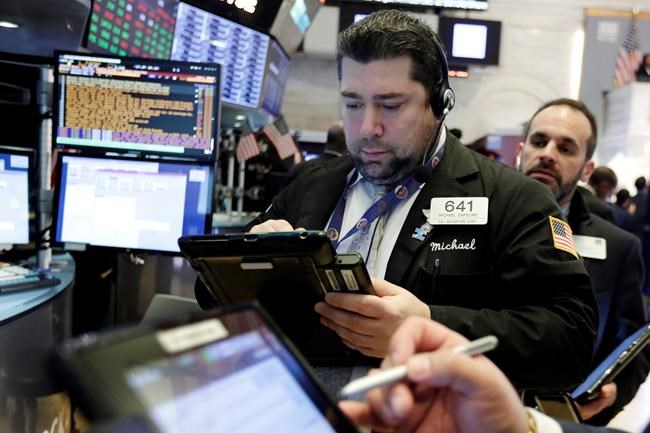Elevate your local knowledge
Sign up for the iNFOnews newsletter today!

NEW YORK – It was another shaky day on Wall Street as indexes rallied in the morning, bobbed up and down for much of the day, then sank in the last few minutes of trading. Energy companies dropped along with oil prices and technology companies also declined.
Stocks were coming off a big gain on Tuesday. At times investors looked ready to jump back in after steep losses Friday and Monday, yet every gain the market made was met with more selling. About 20 minutes before the close of trading the Dow Jones industrial average was up more than 260 points, but it finished with a small loss.
After two steep plunges, including its worst loss in six and a half years Monday, the S&P 500 is down 6.7 per cent from its most recent record high set on January 26.
While markets were noticeably calmer on Wednesday, there are signs that investors are still far more nervous than they were just a few days ago. The VIX, which is called Wall Street’s “fear gauge” because it measures how much volatility investors expect in the future, is currently at 27, more than double where it was two weeks ago. It spiked above 50 early Tuesday.
“The markets had blinders on,” said Invesco Chief Global Markets Strategist Kristina Hooper. “I thought it was almost alarming that markets weren’t considering that, for example, we have a different (Federal Reserve) in 2018 that could be more hawkish.”
Stocks tumbled Friday after the Labor Department said that workers’ wages rose in January at their fastest pace in eight years. That’s good for the economy, but Hooper noted that higher pay to workers can reduce corporate profits, and those profits are the stock market’s fuel. And while higher pay affects company profits quickly, it can take a long time for workers to start spending more money after they get a raise.
The Standard & Poor’s 500 index lost 13.48 points, or 0.5 per cent, to 2,681.66. The Dow slid 19.42 points, or 0.1 per cent, to 24,893.35. The Nasdaq composite fell 63.90 points, or 0.9 per cent, to 7,051.98. Smaller companies fared better than the rest of the market, and more stocks rose than fell on the New York Stock Exchange.
The gap between the Dow’s highest and lowest levels on Wednesday was about 500 points, or 2 per cent. That big, but it’s dwarfed by the lurching moves the market made the last few days.
While investors may still be uncertain about where stocks are going, they’re not rushing for cover in ultra-safe investments like bonds. Bond prices fell, sending yields higher. The yield on the 10-year Treasury note, a benchmark for mortgages and other kinds of loans, rose to 2.84 per cent from 2.81 per cent.
Other safe-play investments also fell. The price of gold fell $14.90, or 1.1 per cent, to $1,314.60 an ounce and silver lost 34 cents, or 2.1 per cent, to $16.24 an ounce.
Precious metals prices often rise when the market hits a rough patch. They climbed in December and January and have actually decreased over the last few days.
Global markets mostly rose and appeared calmer Wednesday. Germany’s DAX was up 1.6 per cent while the British FTSE 100 index rose 1.9 per cent. The CAC 40 in France picked up 1.8 per cent. Hong Kong’s Hang Seng fell 0.9 per cent while Japan’s Nikkei 225 stock average closed up 0.2 per cent. The Kospi in South Korea fell 2.3 per cent.
The biggest technology companies fared the worst. Apple fell $3.49, or 2.1 per cent, to $159.54 and Facebook lost $5.13, or 2.8 per cent, to $180.18. Alphabet, Google’s parent company, lost $29.092, or 2.7 per cent, to $1,055.41.
Wynn Resorts jumped $14.10, or 8.6 per cent, to $177.32 after Steve Wynn resigned as chairman and CEO. The Wall Street Journal reported last month that a number of women accused Wynn of sexual harassment or assault, and said Wynn paid $7.5 million to settle one such case.
Wynn has denied the accusations but said he could not be effective in his corporate positions in the face of those allegations. Wynn stock has fallen 11.6 per cent since the Journal’s report.
Energy companies fell as oil prices sank. Benchmark U.S. crude dropped $1.60, or 2.5 per cent, to $61.79 a barrel in New York. Brent crude, the international standard for oil prices, lost $1.35, or 2 per cent, to $65.51 a barrel in London. That came after the U.S. government said oil production jumped last week, raising concerns about an increase in the supply of crude. Supplies of gasoline and diesel also rose.
Newspaper publisher Tronc soared $3.45, or 19.1 per cent, to $21.55 after it agreed to sell the Los Angeles Times and a group of other newspapers to Dr. Patrick Soon-Shiong, a major Tronc shareholder and former board member, for $500 million.
Snap, the parent of Snapchat, the disappearing-message application, rose $6.69, or 47.6 per cent, to $20.75 after it reported strong user growth and greater-than-expected revenue in the fourth quarter. The stock went public in March and traded above $29 a share shortly after its initial public offering.
In other commodities trading, wholesale gasoline fell 4 cents to $1.77 a gallon. Heating oil lost 5 cents to $1.93 a gallon. Natural gas skidded 6 cents to $2.70 per 1,000 cubic feet. Copper fell 10 cents, or 3.2 per cent, to $3.09 a pound.
The dollar edged up to 109.42 yen from 109.33 yen. The euro fell to $1.2276 from $1.2392.
____
AP Markets Writer Marley Jay can be reached at http://twitter.com/MarleyJayAP His work can be found at https://apnews.com/search/marley%20jayt
Pan Pylas contributed to this story from London.
Want to share your thoughts, add context, or connect with others in your community?
You must be logged in to post a comment.